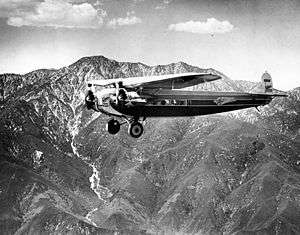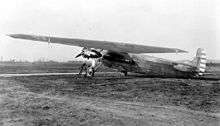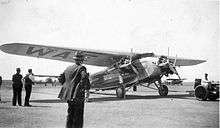Fokker F.10
| Fokker F.10 | |
|---|---|
 | |
| Role | Passenger and military transport |
| National origin | United States |
| Manufacturer | Fokker Aircraft Corporation of America |
| Introduction | 1927 |
| Number built | 65 |
| Developed from | Fokker F.VII |
The Fokker F.10 was an enlarged version of the Fokker F.VII airliner, built in the late 1920s by the Fokker Aircraft Corporation of America. It carried 12 passengers, four more than the F.VII, and had a larger wing and more powerful engines.
Fokker built 65 for U.S. commercial and military service. After the crash of TWA Flight 599 in 1931, which was caused in part by the deterioration of the wooden structure in the F.10's wing, the type was temporarily grounded, and it was required to undergo more frequent and rigorous inspection and maintenance. Its public image was also greatly damaged, leading to its early retirement from U.S. airlines.
Variants

USAAC Fokker C.5
- F.10
- Initial production variant
- F.10A
- Improved and revised 14-passenger variant powered by three 420 hp (310 kW) Pratt & Whitney Wasp radial engines,[1] often called the Super Trimotor.
- C-5
- United States Army designation for the evaluation of one re-engined F.10A powered by three Wright R-975 radials.
- LB-2
- Light bomber version.
- RA-4
- United States Navy designation for the evaluation of one F.10A.
Operators
Civil operators
- American Airways
- TWA
- Pan Am
- Universal Airlines
- Western Air Express (launch customer [2])
- Boston-Maine Airways[3]
Military operators
- United States Army Air Corps designations C-5 and C-7A.[4]
Accidents and incidents
- On June 10, 1929, a Pan Am F.10, registration NC9700 and named Cuba, struck telephone wires and crashed while taking off from Santiago de Cuba bound for Havana, killing two of five on board. The aircraft failed to gain altitude due to a waterlogged runway.
- On March 31, 1931, TWA Flight 599 crashed near Bazaar, Kansas after a wing separated in flight, killing all eight on board, including football coach Knute Rockne.
- On March 19, 1932, an American Airways F.10A, registration NC652E, struck power lines in heavy fog and crashed into an orchard near Calimesa, California, killing all seven on board.
- On September 8, 1932, an American Airways F.10, registration NC9716, crashed into a mountain in poor weather near Salt Flat, Texas, killing three of four on board.
Specifications

Western Air Express Fokker F.10, Oakland, May 1932
Data from Aero Favourites [5]
General characteristics
- Crew: 2
- Capacity: 12 passengers
- Length: 50 ft 7 in (15.41 m)
- Wingspan: 79 ft 1 in (24.10 m)
- Height: 12 ft 8 in (3.86 m)
- Empty weight: 7,716 lb (3,500 kg)
- Loaded weight: 13,007 lb (5,900 kg)
- Powerplant: 3 × Pratt & Whitney Wasp radial engines, 420 hp (313 kW) each
Performance
- Cruise speed: 105 kn (195 km/h)
- Range: 691 nmi (1,280 km)
See also
- Related development
- Aircraft of comparable role, configuration and era
References
- ↑ AAHS Journal: 42. Spring 2004. Missing or empty
|title=(help) - ↑ Living History
- 1 2
- ↑ Cargo Aircraft Designations
- ↑ Aero Favourites
External links
| Wikimedia Commons has media related to Fokker F.10. |
- "The Fokker "F-10" Monoplane: An American-built Three-engined Commercial Model". Flight. XX (50): 1048–1049. December 13, 1928. Retrieved October 17, 2012. A contemporary technical article on the Fokker F-10. (Though the article does not mention the long-winged F-10A, the table of specs at the end appear to be for this version. Specs in the rest of the article are for the original F-10.)
This article is issued from Wikipedia - version of the 4/14/2016. The text is available under the Creative Commons Attribution/Share Alike but additional terms may apply for the media files.